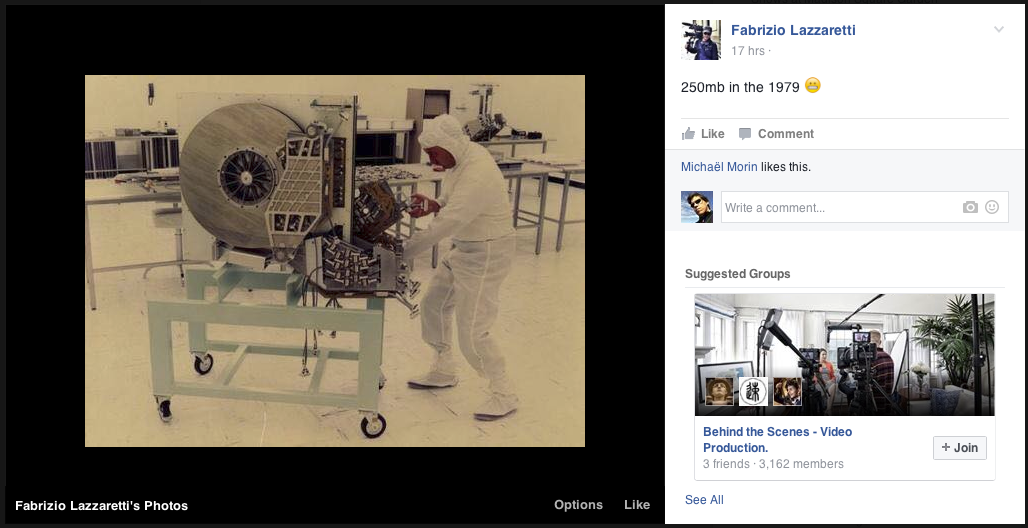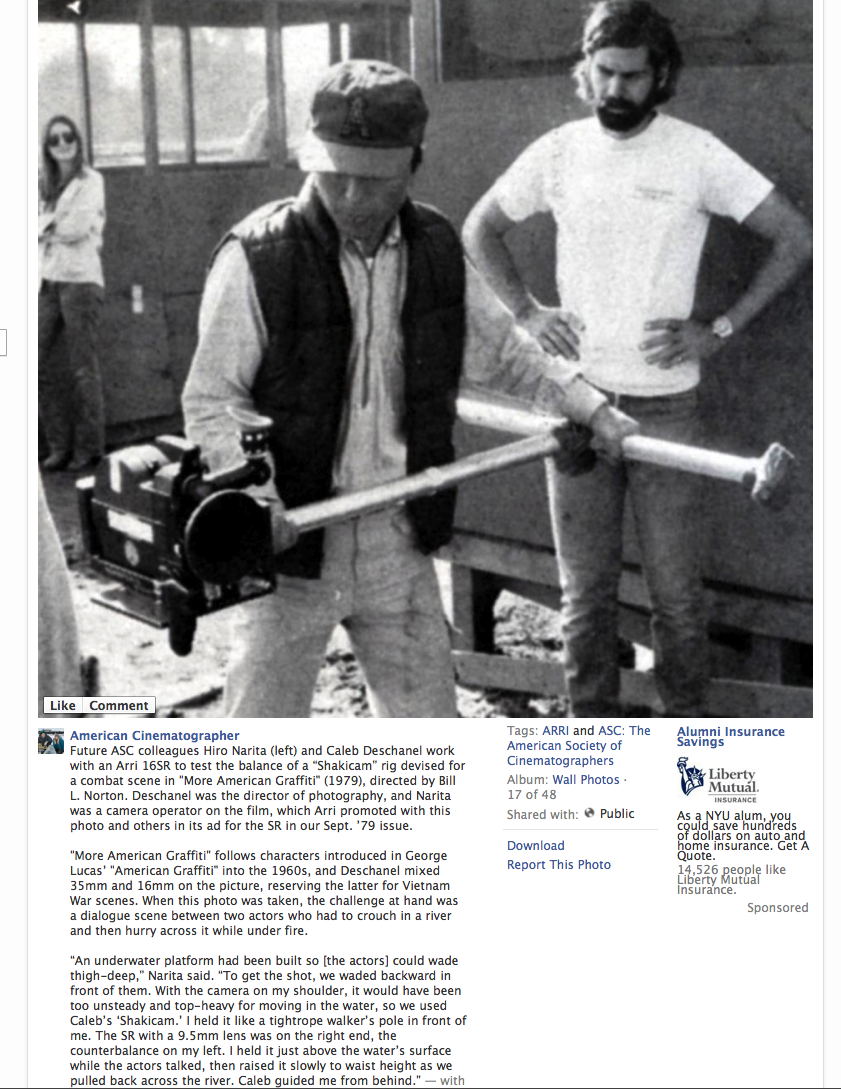
-
@3kids & @bheath. Thanks. I love the "NO SMOKING" sign in Keaton's projection booth! Nitrate! http://en.wikipedia.org/wiki/Film_base#Nitrate
-
OK, this one is purely a joke:
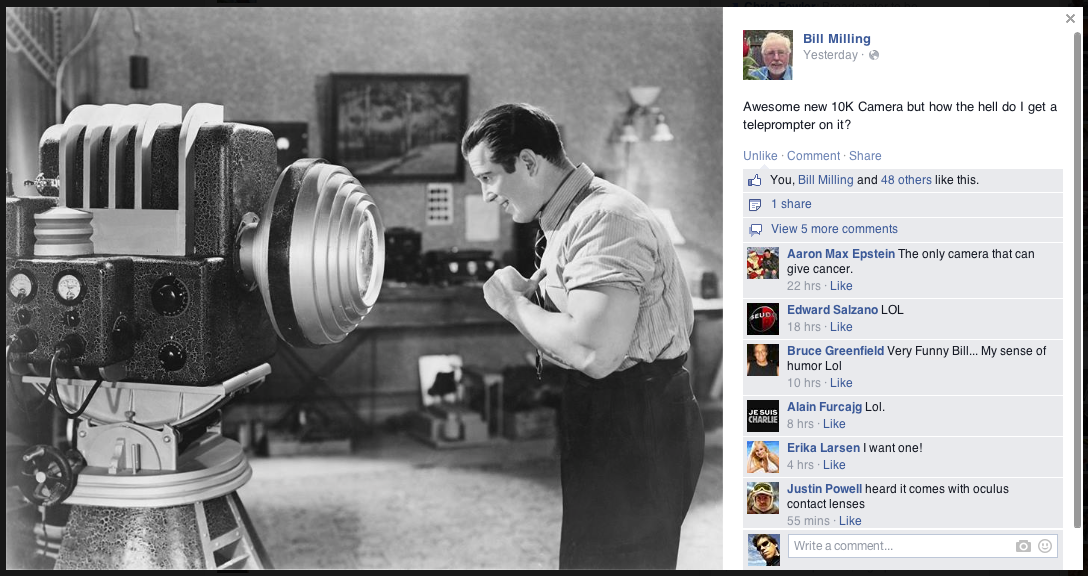

 Screen Shot 2015-02-05 at 10.40.45 PM.png1088 x 576 - 575K
Screen Shot 2015-02-05 at 10.40.45 PM.png1088 x 576 - 575K -

 Screen Shot 2015-03-23 at 6.08.56 PM.png930 x 774 - 576K
Screen Shot 2015-03-23 at 6.08.56 PM.png930 x 774 - 576K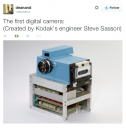
 Screen Shot 2015-03-23 at 6.10.39 PM.png592 x 601 - 281K
Screen Shot 2015-03-23 at 6.10.39 PM.png592 x 601 - 281K -
cool photos.
-
An interesting statement from Scorsese on motion picture film: http://www.ew.com/article/2014/08/04/martin-scorsese-kodak-film-letter?hootPostID=2166c5697009b7969fb400dbcde79d6a
-
There is also a documentary in the works about Jacques Bolsey, the inventor of the Bolex camera.
I believe Paillard, a company in Switzerland, bought the patent and went on to mass produce the camera that Bolsey had designed; renaming it "Bolex". -
According to this video Bolsey was a Russian inventor: Bogopolsky/Boolsky/Bolsey


 Screen Shot 2015-03-24 at 5.58.18 PM.jpg953 x 529 - 50K
Screen Shot 2015-03-24 at 5.58.18 PM.jpg953 x 529 - 50K -
How it was made: the famous scene from "Raiders of the Lost Ark" !!!!
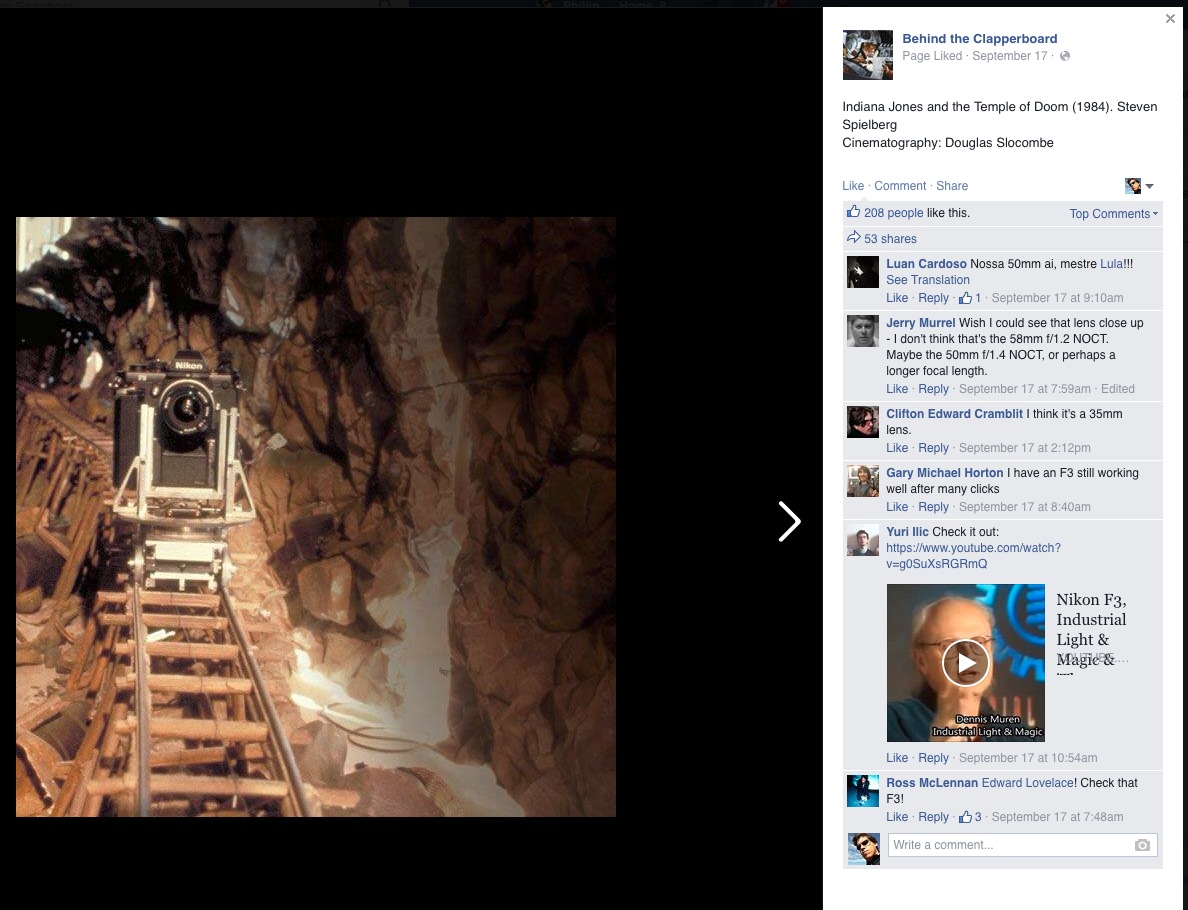

 Screen Shot 2015-10-17 at 9.37.06 AM.jpg1188 x 910 - 229K
Screen Shot 2015-10-17 at 9.37.06 AM.jpg1188 x 910 - 229K -
I found a Facebook page that is a goldmine of old images. I will be posting a few :-)
These are Technicolor 3 strip cameras. This technology was at one time the only way to shoot movies in color (in the USA). There were 3 rolls of B&W film in the mag, each with a color filter on it, so that each strip would record Red, Green, or Blue. All 3 film strips were sandwiched in the gate of the camera in a certain order. After processing, the B&W film strips had colored light projected through them, so the color was added back in, and the 3 color resulting image was recorded on to a single strip of color positive film (something equivalent to Kodachrome or Ektachrome) and that was the copy shipped to the theaters. In the USA Kodak had developed color positive film technology (think "slide film") but hadn't been able to successfully make a color negative film.
Could you imaging loading such a complicated mag in the field, esp. if you got the layers of film mixed up? That would have been a mess, so as I understand it, the mags came pre-loaded from Technicolor.
I think single strip color negative was first developed by Agfa and Kodak only got the technology after WWII as part of the war reparations. My history might be rusty, but, that's what I remember learning here and there in 20 years working with film (and loading a lot of single strip color neg in mags).
Feel free to let me know if I have got anything wrong.
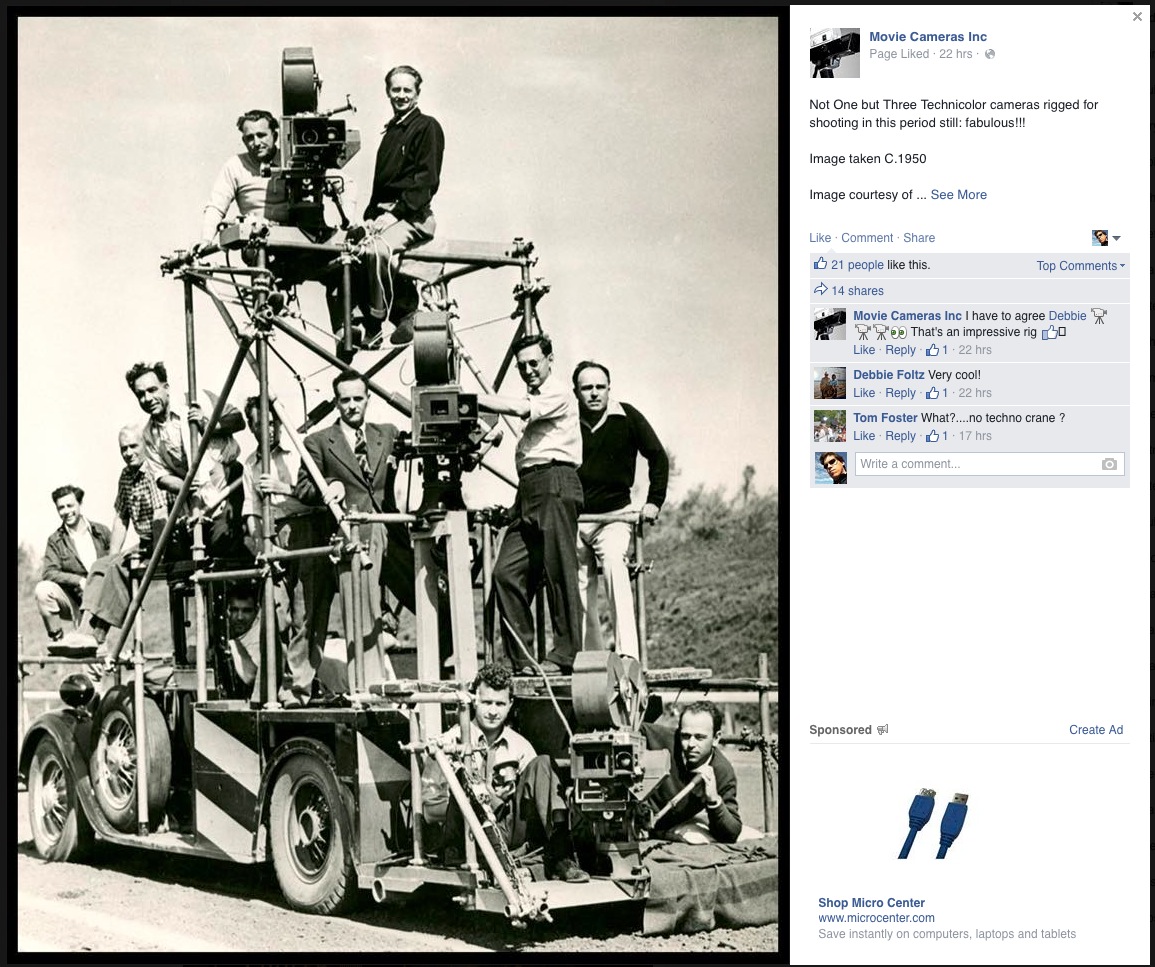

 Screen Shot 2015-10-17 at 6.27.33 AM.jpg1155 x 967 - 340K
Screen Shot 2015-10-17 at 6.27.33 AM.jpg1155 x 967 - 340K -
More details on the process and the inner workings of the camera in this video. This will make you appreciate what we have today, camera-wise, even more:
-
Thanks for posting ;-) Good stuff...
-
Tx @Azo
This is the Cinerama camera. Some of you might have heard of the Cinerama Dome in LA, which was a special theater with a very wide curved screen for the projection of these special Cinerama productions.
https://en.wikipedia.org/wiki/Cinerama#Single-film_.22Cinerama.22
http://www.in70mm.com/news/2012/picture/filming/index.htm
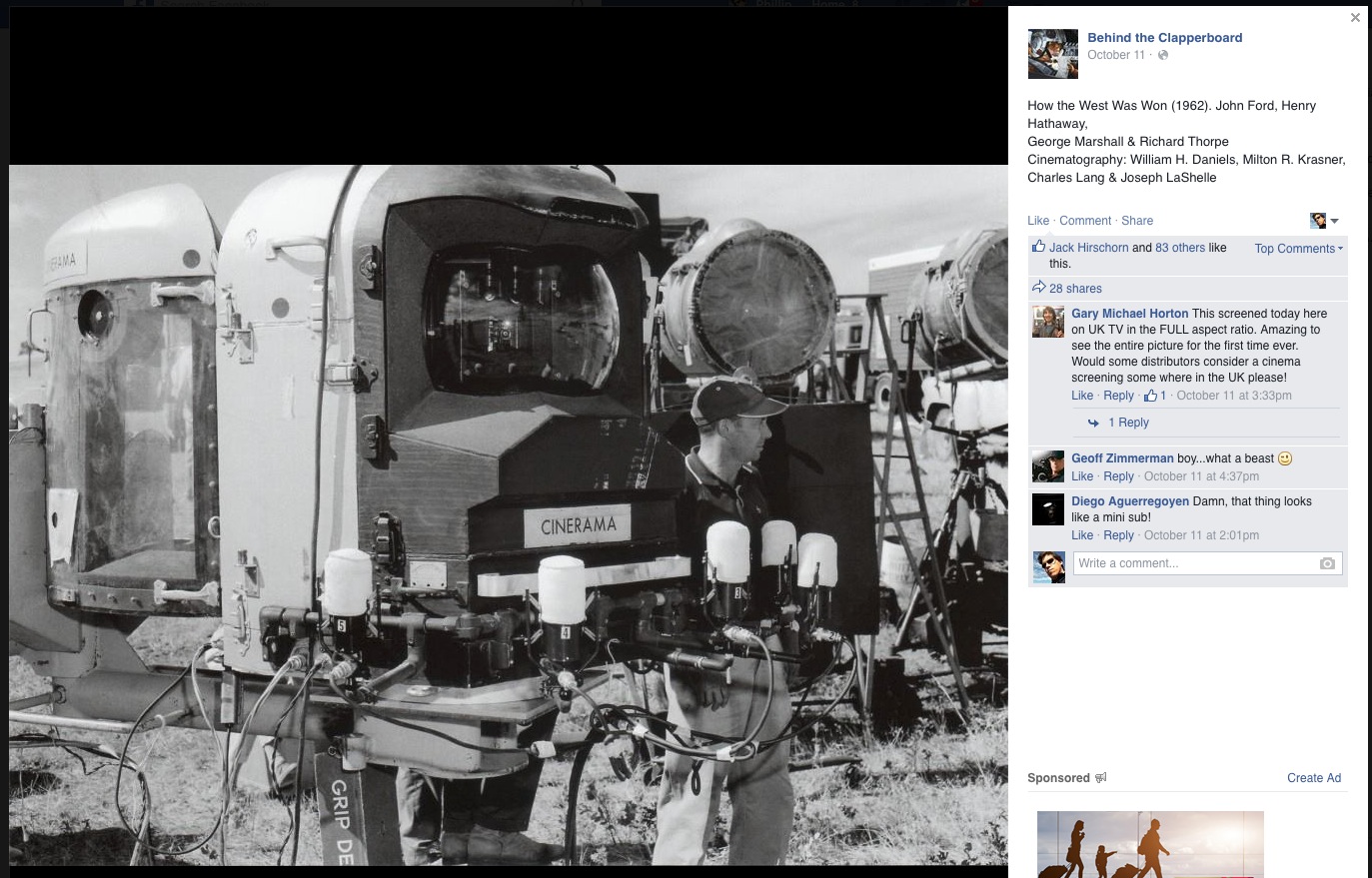

 Screen Shot 2015-10-17 at 7.26.52 AM.jpg1373 x 879 - 329K
Screen Shot 2015-10-17 at 7.26.52 AM.jpg1373 x 879 - 329K -
In 2012 these guys made "a little movie in Cinerama" This is the pre-Anamophic widescreen process. If anyone has ever seen the end result, the process did have issues matching the 2 seams between the 3 cameras. You can see in the diagram below how the 3 projectors were set up to recreate what the camera recorded.
This is a very interesting doc. that shows more of the process than I have ever seen or knew. In the doc they mention it took 5 people to project a film. In the "Seven Seas" doc, they state the image is actually 6 perforations high, whereas standard 35mm images are only 4 perforations high. That's a 50% larger image are, per camera in a 3 camera process. They state the result was an almost grainless image (on screen).
Also, we can all be thankful Cinerama was so complicated, it led to the further development of Anamorphic. It was eventually replaced by UltraPanavision 70 (Anamorphic). more on that here: https://en.wikipedia.org/wiki/Ultra_Panavision_70
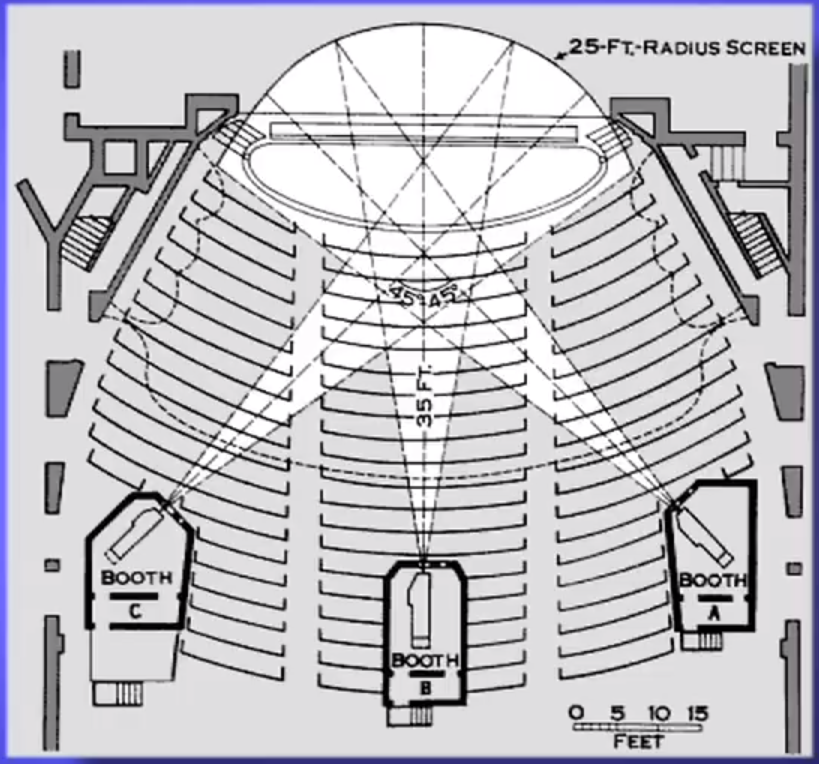

 Screen Shot 2015-10-22 at 2.48.54 PM.png819 x 764 - 596K
Screen Shot 2015-10-22 at 2.48.54 PM.png819 x 764 - 596K -
A good overview from then to now:
-
I think "Marooned" (1969) was the last Cinerama movie I saw at the Cinerama Dome, although shot in single camera Cinerama
One of my favourite 3 camera Cinerama movies is How The West Was Won 1962. Classic Cinerama staging & composition. It's available in a faux Cinerama format called Smilebox, good for projection HDTV.
-
I happened across a video that shows the revolutionary, hand held video camera, tethered to a backpack and then to the control room, show in a post on page 1, actually in action!
It appears at 1:49:
-
Carbon Arc lights are known for their beautiful quality of light output. They also require a lamp operator on each lamp in use, create smoke, which has to be properly ventilated, and, usually someone to service the mechanism inside the lamp, when they are not in use.. = very expensive to use.
My slow roasted chicken story from P.1 is confirmed by some more good stories here:
-
Carbon arc lights were so bright and hot, actors would pass out from heat exhaustion or go blind. The soundstages were so hot, some directors could only shoot for an hour or two, then lights turned off for an hour, as they ventilated the soundstage. Air conditioning didn't help.
The origins of American Film Noir wasn't just an artistic choice, but related to electricity and lighting. During WWII electricity rationing and mandatory blackouts due to possible air raids forced studios to use fewer lights. Outdoor sets had to be hidden with black cloth when shooting at night. Rationing of building materials meant they could reuse sets but disguise them with"film noir" lighting.
Fearing that the Warner Bros soundstages might be mistaken for the Lockheed Aircraft Plant by Japanese bombers, Jack Warner ordered a 20ft arrow to be painted on the roof of a soundstage with a sign that read LOCKHEED - THAT-A-WAY! Although, it should have been written in Japanese not english!
-
@jleo All good points. I only worked with carbon arcs outdoors (simulating sunlight) and in the New York City area, so heat wasn't much of an issue except for a few days in the summer, and it was only the lamp operator's issue (outside), not a problem on the set (inside).
Interesting points about film noir. Thanks!
-
Great Thread :) @CFreak - re: the first digital camera, do you know how/why the cassette was used thats attached to the side?
-
@tubefingers Cassettes were the earliest form of data storage for emerging digital computer technologies. Very early computers used cassette storage too. It's just a compact tape system rather than the large reels of tape the mainframe systems used back then.

 acpc464_8.jpg650 x 506 - 53K
acpc464_8.jpg650 x 506 - 53K -
I remember loading games from tape to my Amstrad 464! - Didn't realise it could be used to record images! That is some seriously old school tech! Be good to see footage of the camera functioning and the quality of the images produced. Any idea how long it took to record/produce images?
Found this:
it took 50 milliseconds to capture the image but 23 seconds to record it to tape, according to the Times. Then Sasson would put the cassette into a player, which would take a further 30 seconds to put up a 100 by 100 pixel black and white image.
Article here
-
@tubefingers no I only reposted the photo I saw on the inter webs.
Howdy, Stranger!
It looks like you're new here. If you want to get involved, click one of these buttons!
Categories
- Topics List23,964
- Blog5,723
- General and News1,342
- Hacks and Patches1,151
- ↳ Top Settings33
- ↳ Beginners254
- ↳ Archives402
- ↳ Hacks News and Development56
- Cameras2,361
- ↳ Panasonic990
- ↳ Canon118
- ↳ Sony154
- ↳ Nikon96
- ↳ Pentax and Samsung70
- ↳ Olympus and Fujifilm99
- ↳ Compacts and Camcorders299
- ↳ Smartphones for video97
- ↳ Pro Video Cameras191
- ↳ BlackMagic and other raw cameras121
- Skill1,961
- ↳ Business and distribution66
- ↳ Preparation, scripts and legal38
- ↳ Art149
- ↳ Import, Convert, Exporting291
- ↳ Editors191
- ↳ Effects and stunts115
- ↳ Color grading197
- ↳ Sound and Music280
- ↳ Lighting96
- ↳ Software and storage tips267
- Gear5,414
- ↳ Filters, Adapters, Matte boxes344
- ↳ Lenses1,579
- ↳ Follow focus and gears93
- ↳ Sound498
- ↳ Lighting gear314
- ↳ Camera movement230
- ↳ Gimbals and copters302
- ↳ Rigs and related stuff272
- ↳ Power solutions83
- ↳ Monitors and viewfinders339
- ↳ Tripods and fluid heads139
- ↳ Storage286
- ↳ Computers and studio gear560
- ↳ VR and 3D248
- Showcase1,859
- Marketplace2,834
- Offtopic1,319




